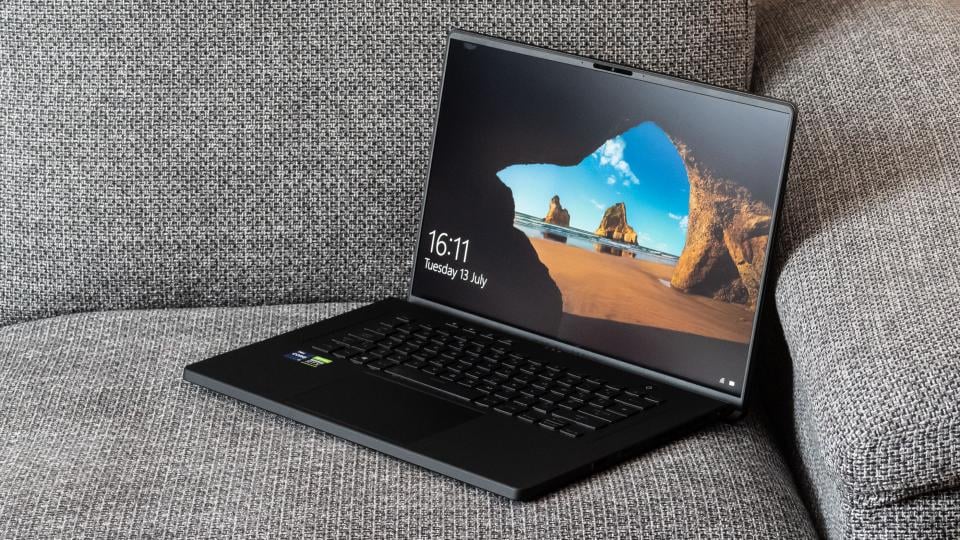
Pros Slim but powerfulFabulous keyboard and touchpadStupendous 165Hz screenCons Not the greatest battery life
The Asus ROG Zephyrus M16 is a gaming laptop worthy of the halls of excellence. Not only does it gather together many of the latest components for top-notch performance, but it squeezes it all into a chassis that’s robust and great to use, topping everything off with a wondrously good display.
It seems as if Asus has hit a rich vein of form this year. Like the Asus ROG Strix Scar 15 and the Asus ROG Zephyrus G15 before it, the M16 is a likeable laptop that’s both powerful and very easy to recommend.
Asus ROG Zephyrus M16 review: What you need to know
It might be for gamers first and foremost, but the Zephyrus M16 is a little different from your run-of-the-mill gaming machines. Instead of a 16:9 aspect ratio, its massive 16in display is 16:10, which is a shape you typically see on productivity laptops and ultraportables.
In fact, that’s the general thrust of the M16. It’s an everyman laptop, one you can power through a few levels of Doom Eternal in the evening and then sling in your laptop bag the next morning and write the monthly report on the train.
Asus ROG Zephyrus M16 review: Price and competition
Four variants of the Zephyrus M16 are available in the UK. The lowest spec model (GU603HE-KR022T) runs the eight-core Intel Core i7-11800H CPU, has an Nvidia 3050Ti graphics card and a 1TB SSD. However, it only has the lower-spec 144Hz 1,920 x 1,200 resolution display.
The most expensive, which coincidentally is the only one currently available to order in the UK at the time of writing, is the GU603HR-KR007R, which is considerably more capable. For £2,299, it comes with an eight-core, 2.5GHz Intel Core i9-11900H, 32GB of DDR4 (3,200MHz) RAM, an Nvidia GeForce RTX 3070 GPU with 8GB of VRAM and a whopping 2TB of storage. This is the model we were sent for this review.
This year, in terms of gaming laptops we’ve reviewed recently, most of the competition comes from Asus’ own stable. More specifically, the Zephyrus M16’s biggest rival comes in the form of the Asus ROG Zephyrus G15, with which the M16 shares plenty of similarities.

ASUS Zephyrus GA503QR 15.6 inch QHD 165Hz Gaming Laptop (AMD Ryzen 7-5800H, Nvidia GeForce RTX 3070, 16GB RAM, 1TB SSD, Windows 10)
£2,181.84 Buy now
Both laptops are the same size and weight; in fact, they have identical chassis, with the ports, vents, keyboard and touchpad located in the same places. The only physical difference is the screen, which is a slightly larger 16in on the M16 versus 15.6in on the G15, and a different aspect ratio. The G15 is also available only with AMD Ryzen 7 and 9 CPUs, whereas the M16 is Intel all the way.
At a slightly cheaper price, you can pick up an Asus ROG Strix G15 for £1,799 with a 165Hz 1440p display plus a Ryzen 7-5800H and an RTX 3070 GPU, or £1,600 with a 300Hz 1080p screen, a Ryzen 7-5800H and an RTX 3060 GPU. It’s a little more plasticky and heavier than the Asus ROG M16, but it’s still a great gaming laptop.
Buy the Asus ROG Strix G15 now from Currys PC World
Asus ROG Zephyrus M16 review: Design and features
If you’re expecting a big, chunky, gaming laptop that’s littered with garish flourishes and LED light bars, then prepare to be disappointed.
For a laptop this powerful, the Zephyrus is surprisingly understated, clad entirely in matte-black metal. The lid has some decoration – a series of pinprick holes reveal a rainbow pattern beneath – but it’s far from over the top.
It’s slender and relatively light, too, measuring a mere 19.9mm thick at the front, rising to 22mm at the rear. It also has a large rubber foot, which lifts the rear of the laptop a further 7mm off the desk.
The Zephyrus’ dimensions are certainly larger than your average ultraportable, but it will slip into the average 15in laptop bag no problem at all. In fact, it weighs a smidge under 2kg without the power brick, which is crazy for a laptop this powerful, and around the same as the sleek Apple MacBook Pro 16in.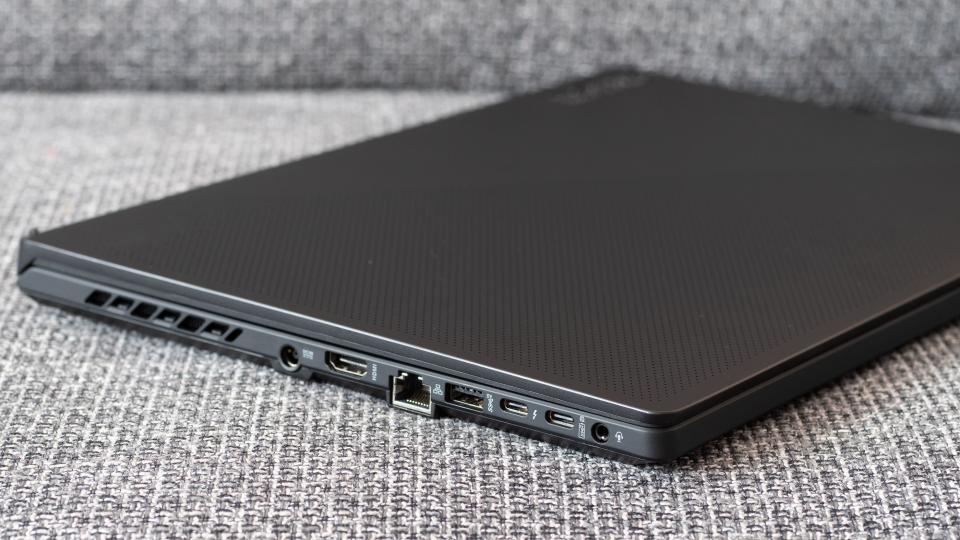
There’s plenty of connectivity scattered around the edges of this machine. I’m not too keen on the placement of the power input on the left-hand side, but the sheer number of sockets available elsewhere makes up for that, with full-size HDMI, two Thunderbolt 4 ports, Gigabit Ethernet, USB-A and a 3.5mm headphone jack on the left. A single USB-A and microSD card slot can also be found on the right.
Flip open the lid and you’ll spot that there’s no number pad, which might irk some, but it does leave plenty of space around the keyboard, so it feels nice and spacious to type on. There’s also a massive touchpad here, which measures 130mm across and 84mm deep.
Both are a joy to use. The keys on the keyboard have a silky, soft feel to them and plenty of positive travel. The touchpad is as reliable as they come, too, although since this is a gaming machine, you’ll almost certainly be using a mouse most of the time.
On the subject of gaming, the only disappointment – if you can call it that – is that the RGB lighting can’t be adjusted on a per-key basis as on the Strix Scar range. You can, however, choose from various effects that influence the whole keyboard, from simple colour cycling to smart effects that reflect CPU usage or temperature.
Asus ROG Zephyrus M16 review: Display
Unusually for a gaming laptop, the Zephyrus ROG M16 comes with a 16:10 aspect ratio screen, which strikes a decent compromise between gaming, entertainment and work capabilities.
Resolution is a crisp 2,560 x 1,600, with a maximum refresh rate reaching 165Hz and a 3ms response time, which the RTX 3070 GPU has no trouble keeping up with. You’re also getting a wide-gamut P3 colour reproduction as well.
The Asus website says it delivers 100% of the DCI-P3 colour gamut, which is true. In testing, I found it was capable of reproducing 107% of DCI-P3. However, it was most colour accurate within Display P3, which is the same colour space that Apple’s current MacBooks target.
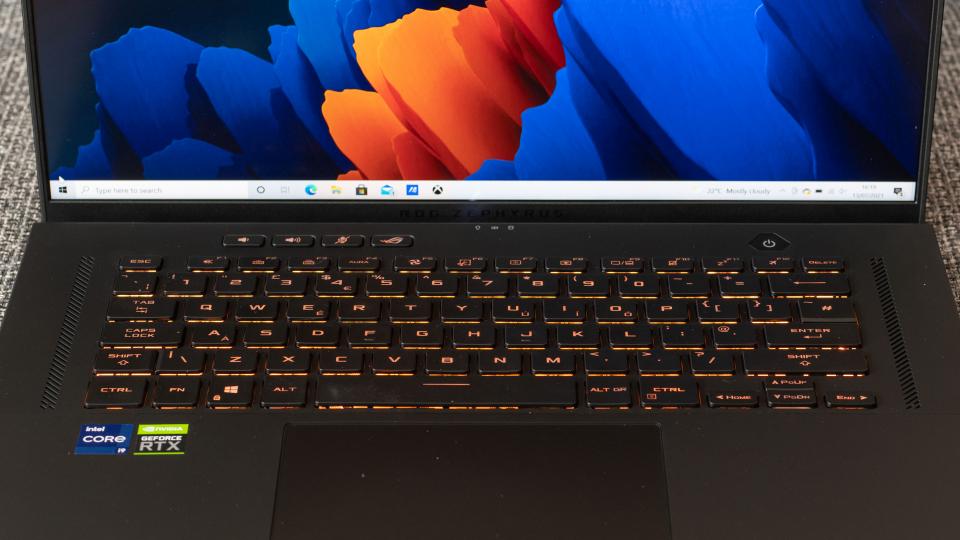
Essentially, it’s the same range of colours as DCI-P3 but with a slightly different gamma curve. Here, the measured average Delta E colour variance score is 1.22, which is frankly superb.
Elsewhere, brightness peaks at a respectable 446cd/m², and I didn’t have any complaints with the M16’s contrast ratio of 1,012:1cd/m² either. Whichever way you look at it, it’s a mighty fine display and as good as anything we’ve seen on any gaming laptop thus far.
Asus ROG Zephyrus M16 review: Performance
The Intel Core i9-11900H inside our review laptop is among the most powerful mobile chips Intel produces today. It has eight cores, a base clock speed of 2.5GHz and a max Turbo frequency of 4.9GHz. This is backed up by 32GB of RAM, an Nvidia GeForce RTX 3070 GPU with 8GB of VRAM, and a 2TB Samsung PM9A1 NVMe SSD for storage.
In testing, the M16 produced some seriously impressive CPU benchmark figures. In our in-house benchmarks, it achieved similar numbers to those produced by the AMD Ryzen 5900HX-powered Asus ROG Strix Scar 15, and it’s slightly ahead on Geekbench 5 as well.
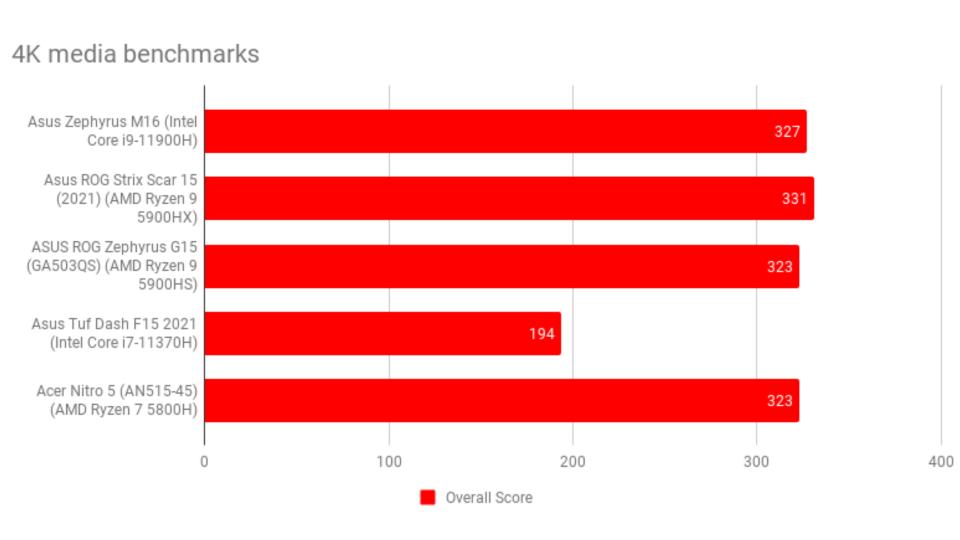
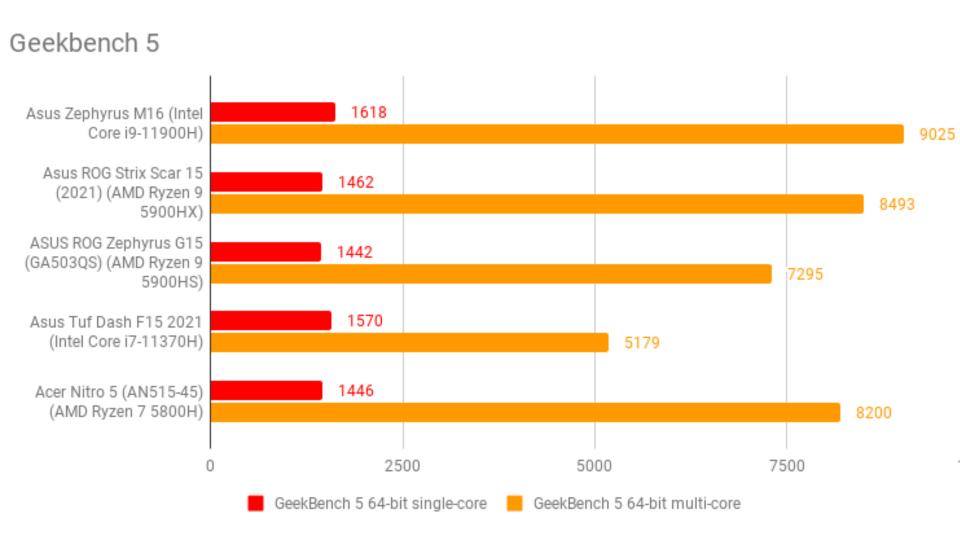
In the gaming benchmarks, performance was equally impressive, with the M16 beating its rivals in the 1080p Metro test by a narrow margin, but losing out to the Asus ROG Strix Scar 15 and friends in the super intense Hitman 2 1080p benchmark.
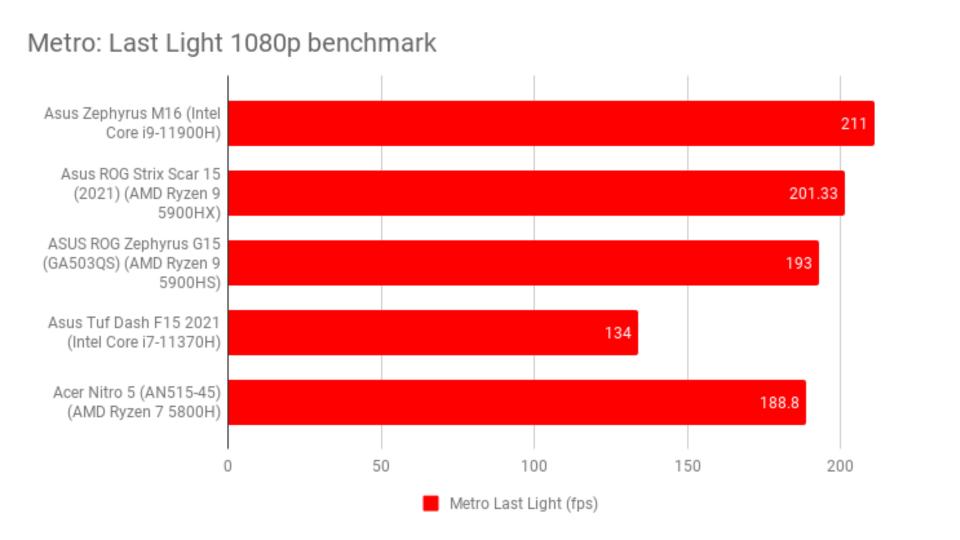
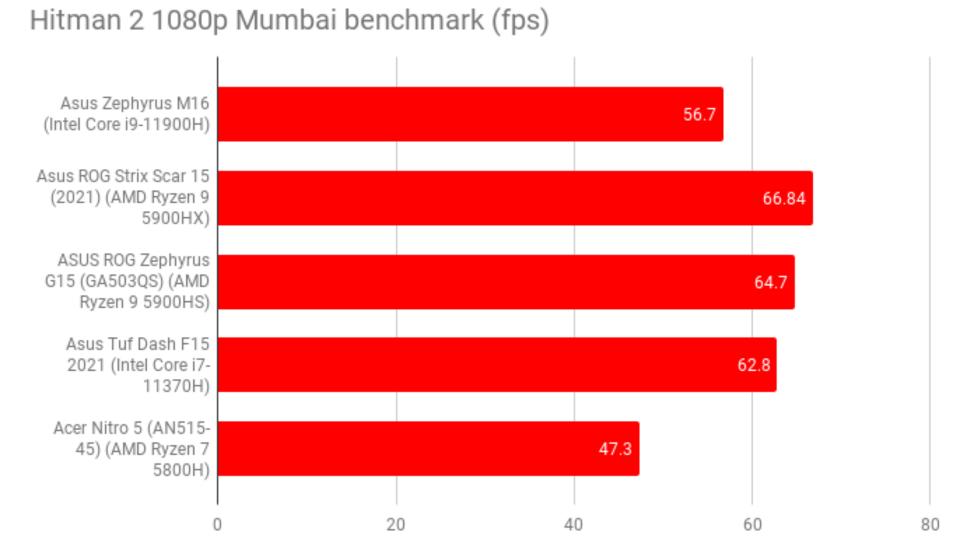
However, it’s more than capable of hitting frame rates of well over 150fps in Doom 2016 at native resolution (2,560 x 1,600), maintaining a sustained frame rate of over 100fps.
Not only that, but your games are going to load stupendously quickly as well thanks to the M16’s lightning-quick Samsung SSD. I recorded sequential read and write speeds of 5,536MB/sec and 4,325MB/sec in the AS SSD benchmark: speeds that effortlessly blow its competitors out of the water, past the beach and into the hotel lobby.
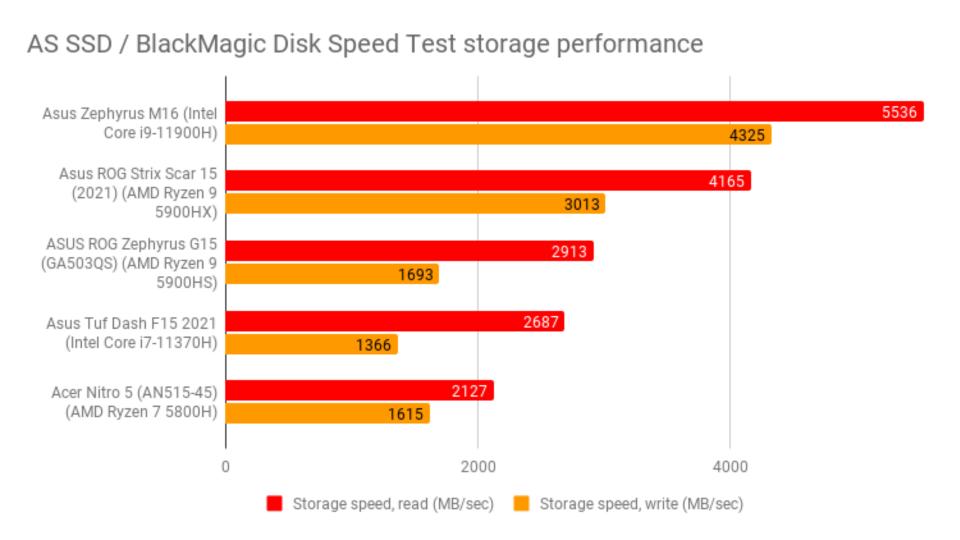
The only fly in the ointment is battery life, which isn’t nearly as impressive. Even with a sizeable 90Whr battery installed and the battery-saving setting enabled, the Asus ROG Zephyrus M16 only lasted 6hrs 9mins in our video rundown test. That’s not terrible, but it’s more than three hours shorter than the Ryzen-powered Zephyrus G15.
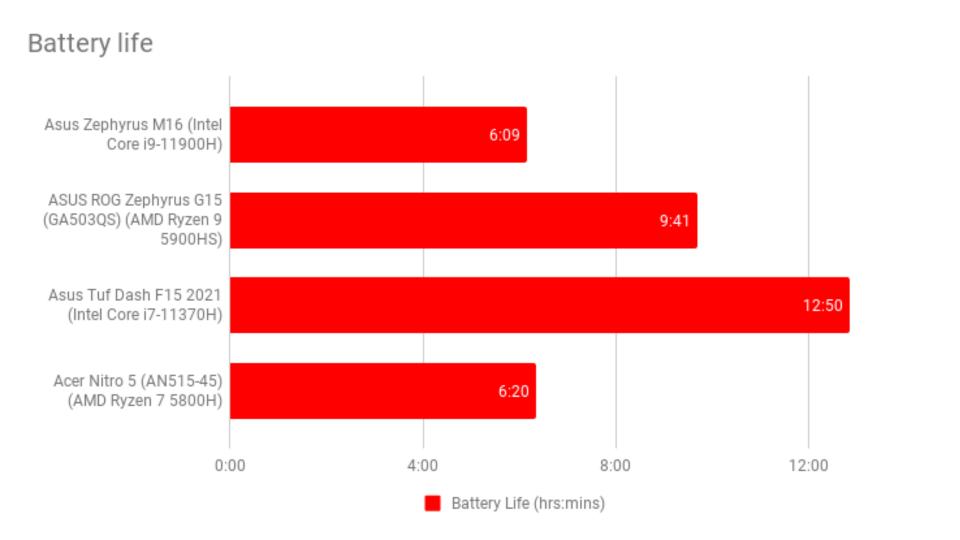
Asus ROG Zephyrus M16 review: Verdict
Despite that slight niggle, I’m still seriously impressed with the Asus ROG Zephyrus M16. It manages to pack a huge amount of power into a slim frame, topped off with rocket-fuelled SSD performance and a spectacularly good display.
It’s a cracker of a machine and, if anything, much better value than the Zephyrus G15 we tested recently. If you stick with the 165Hz display, then you’re getting a gaming laptop that costs £300 less, yet it comes with a bigger screen and a faster, larger capacity SSD. The only sacrifice is the slightly lower level GPU.

